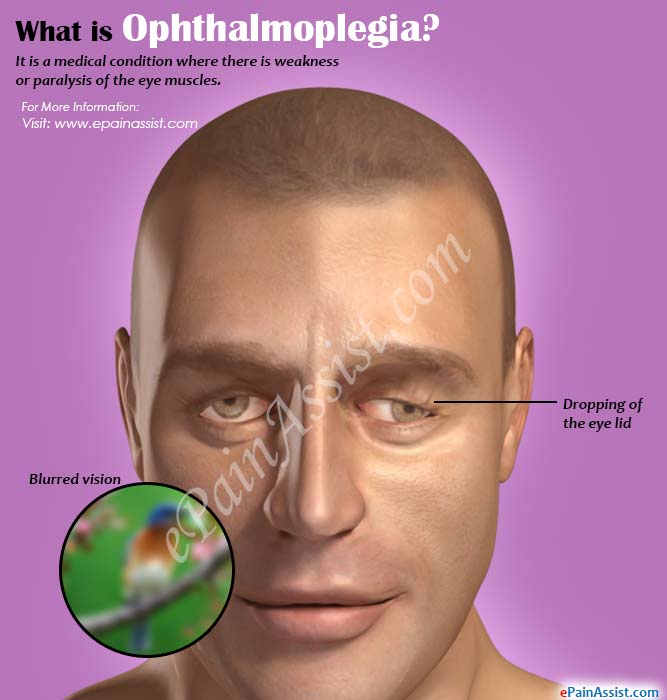What is Ophthalmoplegia?
Ophthalmoplegia is a medical condition where there is weakness or paralysis of the eye muscles (extraocular muscles). There are six muscles which control the eye movements and hold the eye in its place and any one of these muscles can be affected in Ophthalmoplegia. Ophthalmoplegia is also known as Ophthalmoparesis. Patients suffering from ophthalmoplegia can have blurred or double vision. Some of the common causes of Ophthalmoplegia are stroke, thyroid disease and brain injury/trauma. Patients suffering from diabetes are slightly at an increased risk for having Ophthalmoplegia.

Classification of Ophthalmoplegia
Ophthalmoplegia is of two types: Internal ophthalmoplegia and chronic progressive external ophthalmoplegia.
Chronic Progressive External Ophthalmoplegia: This type of ophthalmoplegia often develops in people between the ages of 18 to 40 years. This condition usually starts with drooping of the eyelids and difficulty in controlling the muscles which coordinate the eyes.
Internal Ophthalmoplegia: Internal ophthalmoplegia occurs as a result of damage to the nerve responsible for coordinating the lateral eye movement leading to double vision.
Ophthalmoplegia can involve any or all of the extraocular muscles consisting of the inferior recti, superior recti, lateral recti, medial recti, superior oblique and inferior oblique muscles and it can be classified based on the muscle affected.
Ophthalmoplegia can also be classified on the basis of the directions of the affected movements such as vertical Ophthalmoplegia etc.
Causes & Risk Factors of Ophthalmoplegia
- Ophthalmoplegia can be congenital, i.e. patient can be born with this condition or it can develop later in the patient’s life. It is often caused due to disruption in the messages, which are transmitted from the brain to the eyes.
- The cause of internal ophthalmoplegia is usually trauma, multiple sclerosis and infarction.
- The cause of external ophthalmoplegia is commonly a muscle disorders or mitochondrial diseases, such as Kearns-Sayre syndrome or Graves’ disease.
- Other common causes of ophthalmoplegia include: thyroid disease, brain injury, migraines, stroke, infection and brain tumor.
- Ophthalmoplegia can result from disorders of various parts of the eye and nervous system, such as orbital cellulitis is infection of the eye tissues, which can also lead to Ophthalmoplegia.
- Raised intracranial pressure or cavernous sinus syndrome can also lead to Ophthalmoplegia.
- Parinaud’s syndrome and Foville’s syndrome can also cause Ophthalmoplegia.
- Thiamine deficiency can also cause Ophthalmoplegia occurring as a part of a syndrome known as Wernicke encephalopathy.
- Phenytoin toxicity or intoxication with certain type of substances can also cause Ophthalmoplegia.
- Diabetics are at a higher risk for developing Ophthalmoplegia. Males above the age of 45 and who are diabetic are at a higher risk for Ophthalmoplegia.
- Males with diabetes and above 45 years of age and with type 2 diabetes are also at an increased risk for developing ophthalmoplegia.
Symptoms of Ophthalmoplegia
Blurred or double vision is the common symptoms suffered by patients affected by ophthalmoplegia. Patients with ophthalmoplegia also find it difficult to position their eyes in sync. Some patients have difficulty in moving both the eyes in different directions. Many of the patients will have drooping of their eyelids. If the ophthalmoplegia is related to a systemic disorder then symptoms consist of muscle weakness and difficulty in swallowing.
Diagnosis of Ophthalmoplegia
Physical examination is done to check the eye movements of the patient. CT scan or MRI scan can also be done for a closer examination of the eye. Blood tests are done to determine if the cause of Ophthalmoplegia is some other disorders, such as thyroid disease.
Treatment of Ophthalmoplegia
- Ophthalmoplegia treatment depends on its type, the underlying cause and the symptoms.
- Children who have congenital ophthalmoplegia commonly learn to compensate for their vision problems and may not even be aware of them.
- Adults suffering from Ophthalmoplegia can be fitted for special glasses or alternatively can wear an eye patch to alleviate double vision.
- Patients having ophthalmoplegia due to thiamine deficiency will benefit from administration of vitamin B1.
- Treatment of migraines in some patients can also lead to improvement in Ophthalmoplegia.
Prevention of Ophthalmoplegia
Ophthalmoplegia is generally a symptom of some other disease or syndrome. Regular eye checkups help in early diagnosis of this condition. Our eyes have very delicate muscles, which need a healthy vascular and nervous system to function properly.
Also maintaining a healthy vascular system and a balanced lifestyle helps in decreasing the risk of stroke and problems with vision including Ophthalmoplegia.
Prognosis & Life Expectancy of Ophthalmoplegia
Patients with isolated ophthalmoplegia will have a normal life expectancy with a good overall prognosis. The prognosis of ophthalmoplegia also depends on the underlying cause of this condition. Patients having mitochondrial diseases, genetic diseases, stroke, vascular diseases will have a different outcome depending on each condition. For a good prognosis, Ophthalmoplegia should be diagnosed and treated early.
- Cleveland Clinic. “Ophthalmoparesis.” https://my.clevelandclinic.org/health/diseases/14857-ophthalmoparesis
- Muscular Dystrophy Association. “Ophthalmoplegia.” https://www.mda.org/disease/ophthalmoplegia
- MedlinePlus. “Ophthalmoplegia.” https://medlineplus.gov/ency/article/000742.htm
